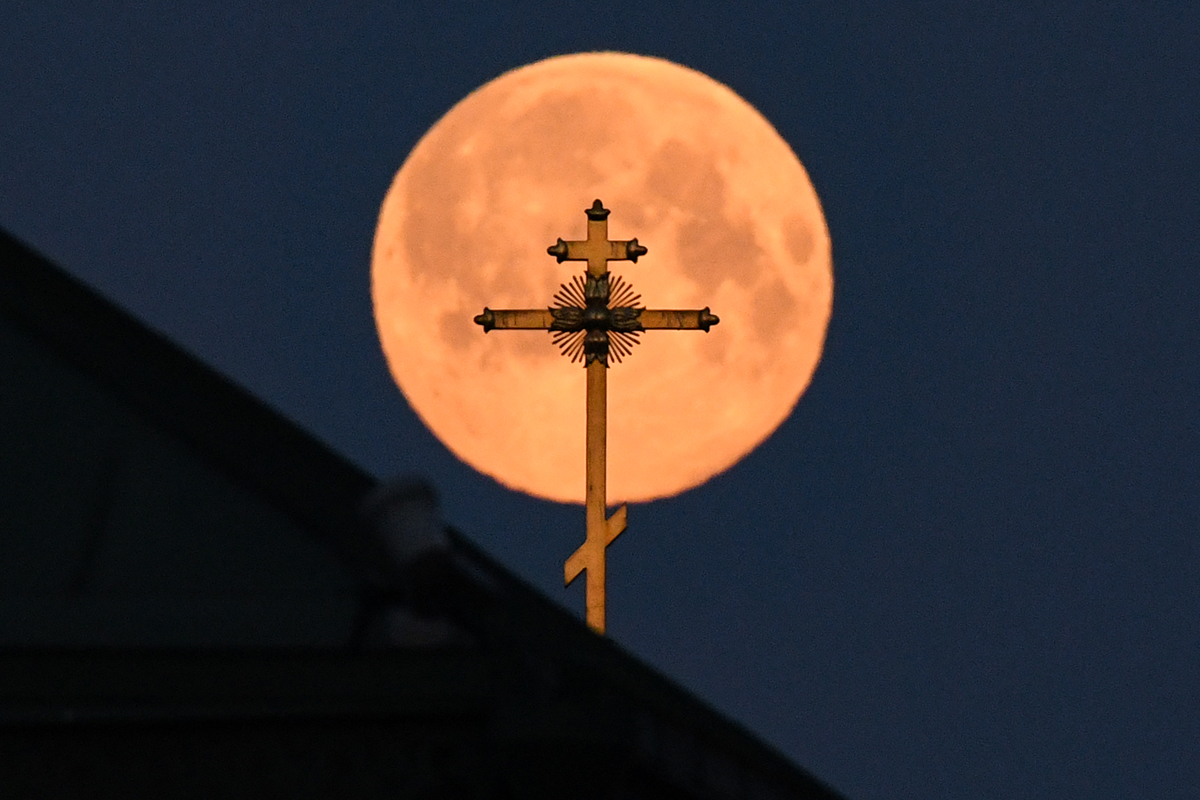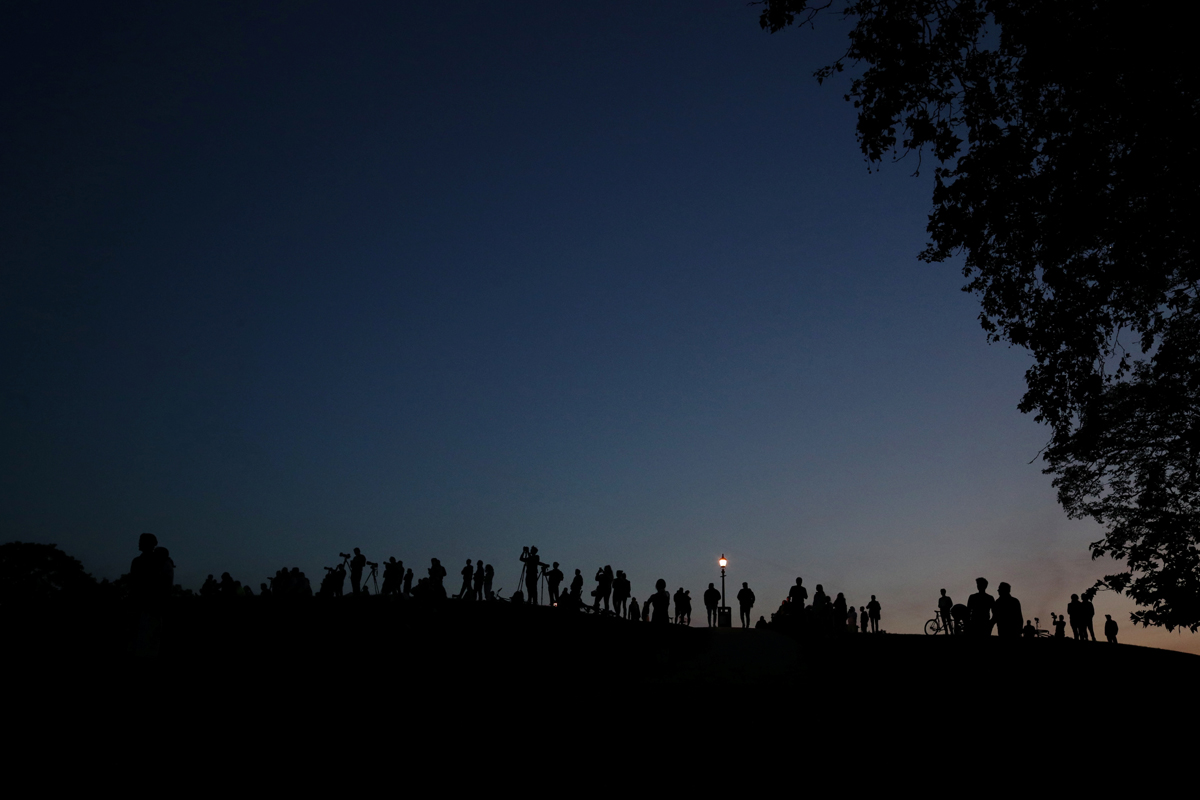In Pictures: 'Full-flower supermoon' amid coronavirus lockdowns
May's full moon occurred over a world beginning to re-emerge after weeks of lockdowns.

This picture shows the closest supermoon to the Earth behind the cross on a church in downtown Moscow. KIRILL KUDRYAVTSEV/AFP
The last "supermoon" of 2020 rose in the night sky on Thursday over a world beginning to re-emerge after weeks of coronavirus-related lockdowns.
The supermoon phenomenon occurs when the moon is within 10 percent of its closest distance to the Earth at the full moon.
May's full moon - at the height of the Northern Hemisphere spring - is also called a "flower moon" - hence Thursday's "full-flower supermoon".
The year's two previous supermoons occurred in March and April.
Clouds over much of Europe and Asia obscured views of the moon, which appears slightly larger than usual - and the streets remained relatively quiet, with many countries still imposing coronavirus-related restrictions.
But from Hong Kong to Jerusalem to Caracas, some locals donned masks and ventured out to take photos of the celestial spectacle.

The full moon rises above the Camlica Mosque in Istanbul, Turkey UMIT BEKTAS/REUTERS

The full moon, also known as the supermoon or Flower Moon, rises above the Statue of Liberty. BRENDAN MCDERMID/REUTERS

The Flower Supermoon rises over Curitiba, Brazil. The supermoon is visible as the full moon coincides with the satellite in its closest approach to Earth, which makes it appear brighter and larger than other full moons. DANIEL CASTELLANO/AFP

Silhouettes of media members and people document the full moon over Primrose Hill, London, Britain HANNAH MCKAY/REUTERS

The full moon is seen next to Tower Bridge, London, Britain SIMON DAWSON/REUTERS

The full moon rises over a mosque minaret on the 14th day of the holy fasting month of Ramadan, in Amman, Jordan MUHAMMAD HAMED/REUTERS

A bird flies past the full moon as it is seen behind the Lomonosov Moscow State University in Moscow, Russia SHAMIL ZHUMATOV/REUTERS
May's full moon occurred over a world beginning to re-emerge after weeks of lockdowns.

This picture shows the closest supermoon to the Earth behind the cross on a church in downtown Moscow. KIRILL KUDRYAVTSEV/AFP
The last "supermoon" of 2020 rose in the night sky on Thursday over a world beginning to re-emerge after weeks of coronavirus-related lockdowns.
The supermoon phenomenon occurs when the moon is within 10 percent of its closest distance to the Earth at the full moon.
May's full moon - at the height of the Northern Hemisphere spring - is also called a "flower moon" - hence Thursday's "full-flower supermoon".
The year's two previous supermoons occurred in March and April.
Clouds over much of Europe and Asia obscured views of the moon, which appears slightly larger than usual - and the streets remained relatively quiet, with many countries still imposing coronavirus-related restrictions.
But from Hong Kong to Jerusalem to Caracas, some locals donned masks and ventured out to take photos of the celestial spectacle.

The full moon rises above the Camlica Mosque in Istanbul, Turkey UMIT BEKTAS/REUTERS

The full moon, also known as the supermoon or Flower Moon, rises above the Statue of Liberty. BRENDAN MCDERMID/REUTERS

The Flower Supermoon rises over Curitiba, Brazil. The supermoon is visible as the full moon coincides with the satellite in its closest approach to Earth, which makes it appear brighter and larger than other full moons. DANIEL CASTELLANO/AFP

Silhouettes of media members and people document the full moon over Primrose Hill, London, Britain HANNAH MCKAY/REUTERS

The full moon is seen next to Tower Bridge, London, Britain SIMON DAWSON/REUTERS

The full moon rises over a mosque minaret on the 14th day of the holy fasting month of Ramadan, in Amman, Jordan MUHAMMAD HAMED/REUTERS

A bird flies past the full moon as it is seen behind the Lomonosov Moscow State University in Moscow, Russia SHAMIL ZHUMATOV/REUTERS
![A supermoon rises over Mow Cop Castle near Stoke-on-Trent, central England [Oli Scarff/AFP]](https://www.aljazeera.com/mritems/Images/2020/5/8/5b31ef2086f64a51a89e7e89e435578f_8.jpg)
A supermoon rises over Mow Cop Castle near Stoke-on-Trent, central England
OLI SCARFF/AFP
No comments:
Post a Comment